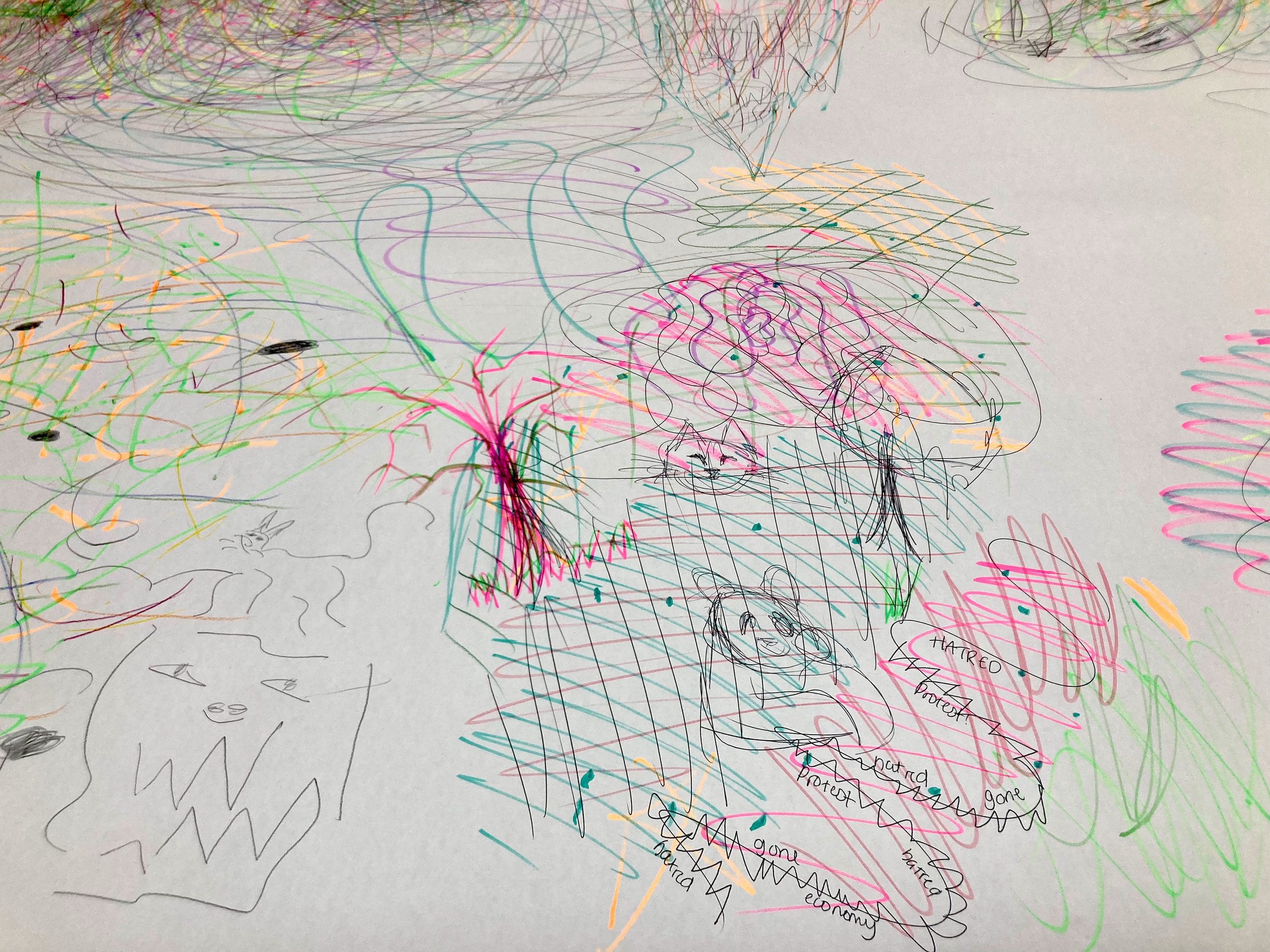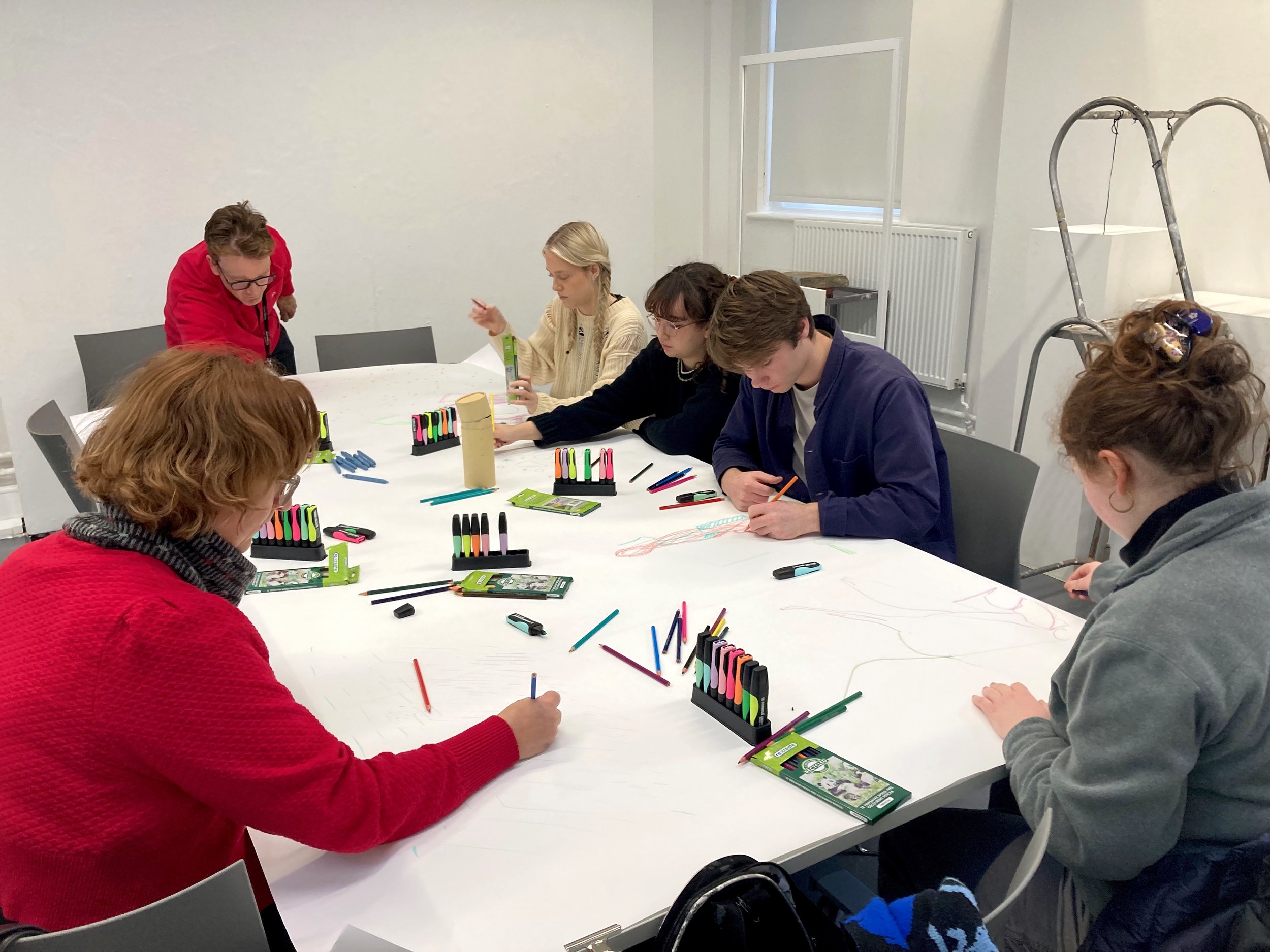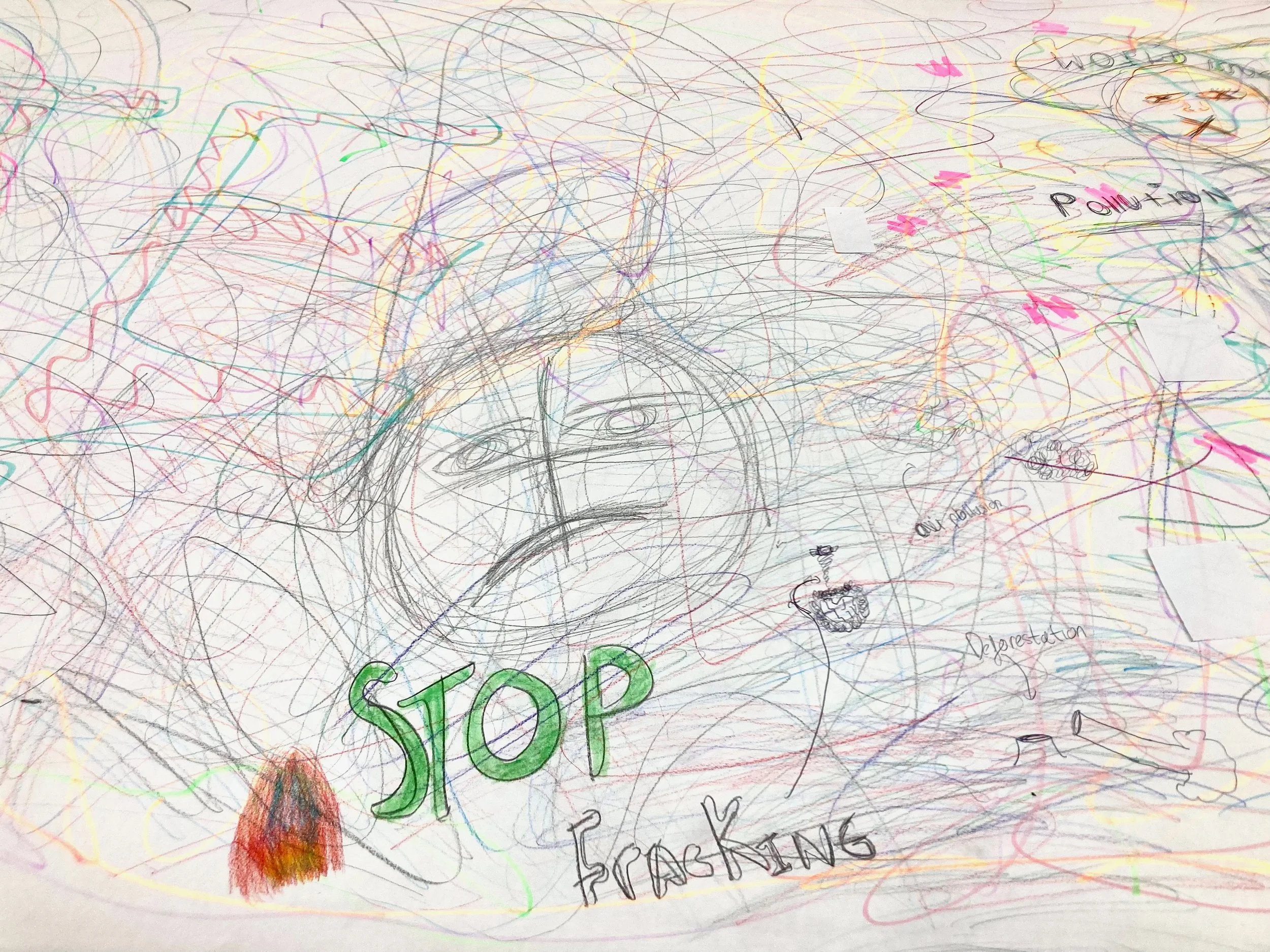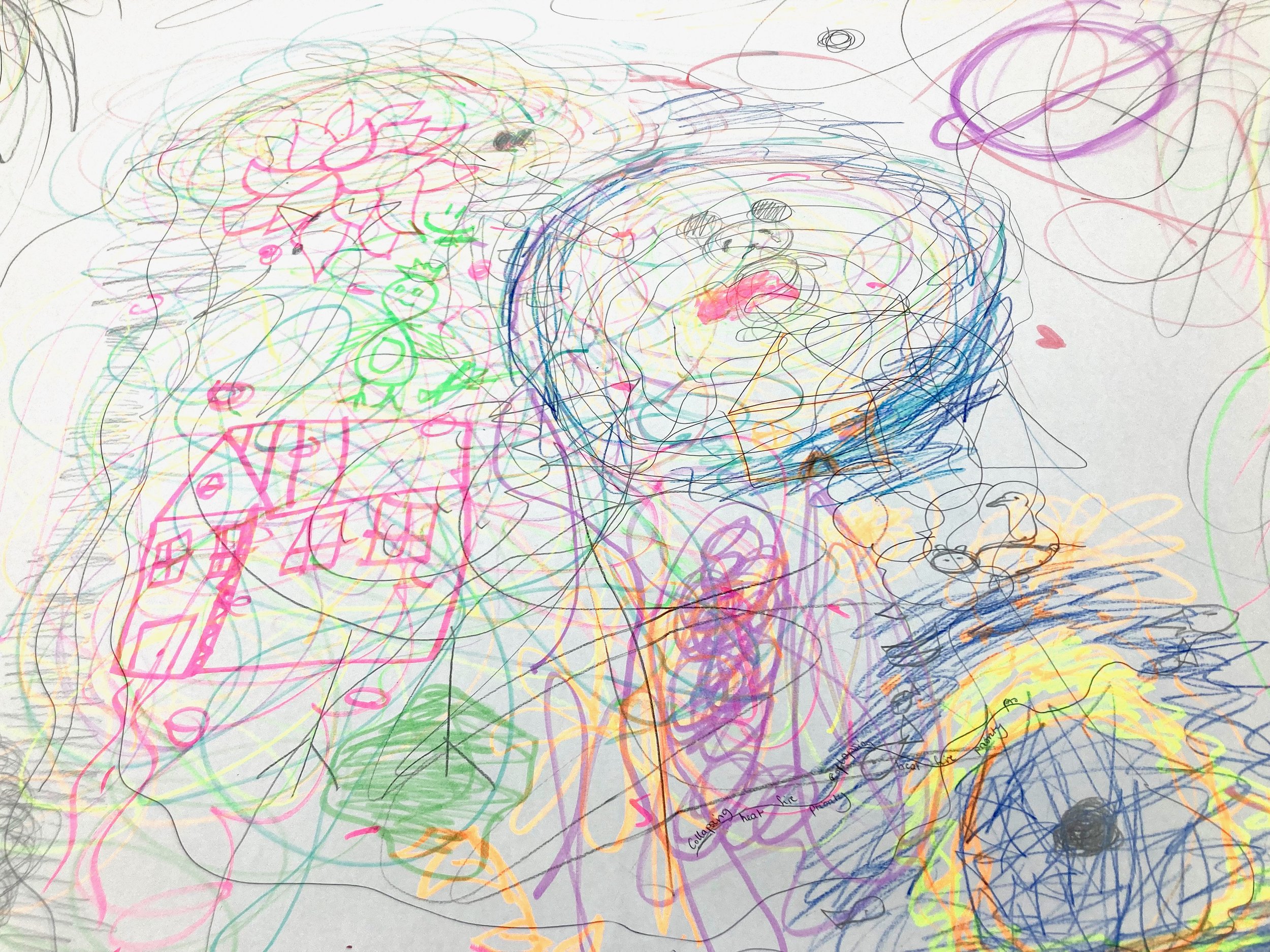Drawing & Writing
Ecological arts methods in drawing and writing have been developed by Dr. Miranda Matthews and Dr. Francis Gilbert. Miranda and Francis had previously led workshops for adult students. They have also published co-authored articles about how free writing and drawing can access emotional and affective responses at times of crisis and difficulty.
Miranda and Francis are researching how methods of writing and drawing could be taken up by young people who want to express themselves about the Earth Crisis. In the CAL and CMUK Ecologies in Practice workshops, young people aged 14-18 and undergraduate students were introduced to activities that use expressive drawing and writing, to help inspire empathic, empowering creative responses.
This video shows Miranda introducing the workshop and some key topics
Intentions and Content
At the start of the drawing and writing workshops, students were asked to discuss what they currently love about being in the world, to bring to the fore aspects of being on Earth that are cherished and for protection. Miranda then showed students the work of some of the artists who have explored issues of the Earth Crisis, such as loss of biodiversity and the effects of extractivist fracking.
With the examples of Miranda’s ten minute abstract drawings (see below), the workshop participants then explored expressing their feelings in abstract mark-making. The drawings started with energetic, non-representational and colourful responses. Then the participants were encouraged to add in their own representations of living beings and natural forces that are affected by the Earth Crisis.
A 10 minute drawing, featuring green and pink edged swirls above green landscape.
Five 10 minute drawings displayed on a white wall
A 10 minute drawing, featuring two sets of multi-coloured star shapes placed either side of a bank of blue speckles
The drawings were made in collaboration, on long stretches of paper. It was important that all of the materials for this project were also ecological: materials were made from recycled paper and plastic, for holistic, environmentally active making processes.
After ten minutes of drawing, focused expressive writing was introduced. Francis read a poem that relates to Earth Crisis issues, and then invited the participating students to write whatever came up for them, in relation to their interpretations of the poem, and the feelings it helped to create. Then students chose four words from their writing to add to their drawing. Miranda asked the students to create a ‘line of flight’ with their words on the drawings, connecting with the posthumanist theories of Deleuze and Guattari.
The elements of focused and expressive drawing and writing were assembled, by each student working in their area of the collaborative artwork. The group then talked about how they had experienced each stage of the workshop, and how the combined visual and verbal languages connected to gather new meanings and expressive voices.
Students gather round a table covered in white paper to draw and write
A drawing of a brown tree-like shape drawn during the first workshop
Map-like drawing and shapes made by students during the first workshop
A large number of students draw and write on a table while standing
Yellow cell-like shapes with pink outlines and green tendrils, drawn during the first workshop
Observations and Development
In the first workshop with school students, the Drawing and Writing practice researchers – Miranda and Francis, wanted to focus on two main issues for the Earth Crisis: loss of biodiversity and air pollution. Miranda referenced artworks that draw attention to how the Anthropocene – the relatively recent human era in the Earth’s history – is driving many species other than humans to extinction. These artworks included a painting Rain, Steam and Speed made by JMW Turner in 1844 at the time of the industrial revolution. Contemporary artworks referenced included Marina Vitaglione’s Air (2020), Cy Hutchison’s Cobbler (2022) and Es Devlin’s Come Home Soon (2022). Devlin had made an immersive drawing and sound artwork outside the Tate Modern, including showing drawings of 243 at risk species in London. Francis read the decolonial poem Gene, by Mario Petrucci. This poem is written in what can be interpreted as a patois language of future humans, who are raised in a polluted environment.
When the student participants got to the ‘free writing’ stage of the first workshop, they wrote whatever came up for them, on any topic, to let out whatever was there for them. They were then asked to use four words from the poem that Francis had performed, to make the ‘line of flight’ on the drawing. There were some inspiring expressive, embodied and dynamic drawings and free writing created by students.
Miranda and Francis found however, that too much was brought into play to be addressed by the participants in the time that school students had for the workshop, or to focus their empowered voices on creative interventions in the Earth Crisis. Miranda felt that young people’s own voices, drawings and writings needed to be more centralised in the practice research narratives that make the collaborative artworks. The research team as a whole also decided to focus on the causes of the Earth Crisis more than the impacts, to get to the places where young people could feel more energised to make their own creative interventions. Therefore, the Drawing and Writing approach changed and adapted to what happened in practice.
Second Workshop
In the second workshop undergraduate students at Goldsmiths were introduced to the work of one artist, Caragh Thuring that explores the explosive more-than-human forces of the Earth such as volcanoes, that come into tensions with structures made by people. After drawing, they heard a poem by James Tierney, They Came for the Shale (2017), about fracking as an intrusive extractivist practice. This time the participants chose words from their own free writing to add to the visual language of their collaborative drawing, to emphasise the agency of their creative voices.
The undergraduate student participants still wrote about whatever came up for them in ‘free writing’ that enables nuanced creative expressions and affective release. Some participants found that this approach did not enable them to fully access their feelings of protest about climate change. Again our methods adapted, in response to the questions and comments of those participating in the workshop.
Multi-coloured swirls drawn on white paper during the second workshop
Drawing of a pink octopus-like shape on a white background
Six seated university students draw and write on paper during the second workshop
A drawing of pink and blue lines in a comet formation converging a dark brown circle
Green and purple lines on white paper
Third Workshop
Our third workshop with school students brought together all our findings in practice research workshops one and two. Miranda and Francis focused on artwork and poetry about fracking and extractivism, to enable focused, expressive voices in drawing and writing. Miranda linked to the photographic work of Nina Berman, Fractured: The Shale Play in addition to showing her ten minute drawings, and Francis again read the James Tierney poem. The research team changed tack, from releasing affective forces that came up for young people in the course of discussing the Earth Crisis, to enabling spaces for focused, expressive protest.
Several students participants stand to draw and write on shared paper
Close-up of a student working on his drawing and writing in the third workshop
Close-up view of some of the work produced, with scribbles, a face and the words Stop Fracking
Overview of one of the shared drawing and writing papers
Overview of one of the shared pieces of paper from the workshop
Writing from the Workshops

A student participant reads her poem aloud during a workshop
THE SUNFLOWER DIES FROM AN EXCESS OF SUN
THE OCEANS EVAPORATE, WE ARE LEFT WITH DRY, (UN?)INHABITABLE CANYIONS
BUT STILL THE EARTH BURNS, STILL THE EARTH SPINS.
THE OCEANS ARE RISING,
BUT THE EARTH STILL SPINS,
THE TREES ARE FALLING,
BUT THE EARTH STILL SPINS
WE CANNOT BREATHE…
BUT THE EARTH STILL SPINS.
Protest, machines, pollution, drilling into the Earth, fire, dangerous, loud, disturbing, emotional, fossil fuels, planet, green, trees, ocean, nature
You look at the window,
you see the perfect view,
blink!
And giant hole appears in front of you.
You look at the picture,
you see the polar bear,
blink!
And you couldn’t find it anywhere.
You look at the sea,
you see the fishes and crabs
blink!
And you staying alone in front of dead view
I think climate change is bad and the rich people borrow holes in the earth and looking for fossil fuels and materials. The deforestation is bad as our C02 isn’t getting cleaned.
Fish – harmful – plastic. Trees – Cutting down – toooo many Cars – Petrol – Diesel – Electric – Foods – first food – Natures foods.
The world is ending and nobody is doing anything about it. Everyone is just watching the world die and not doing anything about it, not thinking about consequences of our actions. If we don’t stop climate change, we and our world will cease to exist.
Pollution deforestation
Fracking
Fossil Fuels
animals dying
climate change
waste products
carbon dioxide
Fires
Temperature
The countryside is being destroyed, climate awareness, destruction, collective social responsibility, urbanisation protest, death, eco-system destruction, corruption, death, global warming, nature.
Reflections and Feedback
Miranda and Francis found that the Drawing and Writing practice research method had to respond to the voiced expressions of the participants, and their experiences of making in practice research. In the series of Drawing and Writing workshops for this Ecologies in Practice project, the research team learned from each other, and observed how participants responded to the combined experiences of working with each of the three arts methods in the same workshop. It could be observed that connection, collaboration and focus were of central importance. Yet these conditions of engaged interaction and emancipated youth voice were also arrived at in holding onto aspects of play, acceptance, inclusivity and individuation among the participating young people.
“I think it was quite freeing. Like with the drawing if it linked to anything that we wanted to draw we could just draw it, even if it was just a scribble it didn’t matter because it meant something. Even if no one else understood it you understood it”
“Yes I really like it because you didn’t have to focus on making it look pretty or anything you could just draw the way how you felt basically. You could draw big, draw small, how you wanted to, but then, yes that’s how I felt. I liked it.”
“I think this exercise was really interesting. I felt like free drawing and free writing were on a similar level to me in terms of helping me work through my thoughts and I realised that was much more intense than the drawing. So now I feel I should be doing more of the free drawing as a way of working through things or ideas, so I think that would be good to share with people.”
Play video to see Miranda inviting reflections and feedback from workshop participants
Inspired?
Access our free resource library to help run your own workshop.
Please recognise our project when using our work, and get in touch if you are interested in finding out more about our methods and findings.




















